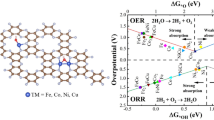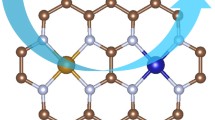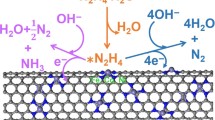Abstract
Single atom catalysts are promising for enhancing performance of electrocatalytic CO2 reduction reaction (CO2RR). Herein, first-principle calculations were conducted to investigate the mechanism of two electron/proton transfers during CO2RR on two types of structures of single metal atom with four coordinated nitrogen atoms (M‒N4, M = Fe, Co, Ni, and Cu), namely metal phthalocyanine (MPc) and metal anchored nitrogen-containing carbon (M‒NC). Our results demonstrate that nitrogen-containing carbon plane effectively immobilizes and activates metal centers. The physical adsorption of CO2 suggests that the initial activation of CO2 proceeds through a concerted proton-electron transfer step. M‒NC surfaces exhibit higher favorability toward reactions of CO2 → *COOH and CO2 → *HCOO compared to MPc with the same metal center. Noteworthily, MPc structures featuring pyrrolic N coordination environment exhibit greater stability, whereas M‒NC with pyridinic N coordination environment demonstrate higher activity in the initial reduction of CO2. CoPc and Fe‒NC are the optical catalysts for achieving high CO2RR performance in the formation of CO and HCOOH, respectively. The strong binding of *COOH/*HCOO on catalyst can effectively reduce the reaction energy required for its subsequent reduction. The results of this study provide profound insights into the intricate coordination environment and the distinct role by various metal centers in M‒Nx materials.
Graphical abstract
Both central metals and coordination environment of single atom catalysts have great influence on CO2RR. Metal anchored nitrogen-containing carbon catalysts are more favorable for activation of CO2 while metal phthalocyanine catalysts exhibit higher stability. CoPc and Fe‒NC are the optical catalysts for achieving high CO2RR performance in the formation of CO and HCOOH, respectively.








Similar content being viewed by others
Data availability
Data will be made available on request.
References
Li L, Li X, Sun Y, Xie Y (2022) Rational design of electrocatalytic carbon dioxide reduction for a zero-carbon network. Chem Soc Rev 51:1234–1252. https://doi.org/10.1039/d1cs00893e
Birdja YY, Pérez-Gallent E, Figueiredo MC, Göttle AJ, Calle-Vallejo F, Koper MTM (2019) Advances and challenges in understanding the electrocatalytic conversion of carbon dioxide to fuels. Nat Energy 4:732–745. https://doi.org/10.1038/s41560-019-0450-y
Overa S, Ko BH, Zhao Y, Jiao F (2022) Electrochemical approaches for CO2 conversion to chemicals: a journey toward practical applications. Accounts Chem Res 55:638–648. https://doi.org/10.1021/acs.accounts.1c00674
Gao D, Arán-Ais RM, Jeon HS, Roldan Cuenya B (2019) Rational catalyst and electrolyte design for CO2 electroreduction towards multicarbon products. Nat Catal 2:198–210. https://doi.org/10.1038/s41929-019-0235-5
Seh ZW, Kibsgaard J, Dickens CF, Chorkendorff I, Norskov JK, Jaramillo TF (2017) Combining theory and experiment in electrocatalysis: Insights into materials design. Science 355:eaad4998. https://doi.org/10.1126/science.aad4998
Zhang Q, Guan J (2020) Single-atom catalysts for electrocatalytic applications. Adv Funct Mater 30:2000768. https://doi.org/10.1002/adfm.202000768
Wang Y, Su H, He Y, Li L, Zhu S, Shen H, Xie P, Fu X, Zhou G, Feng C, Zhao D, Xiao F, Zhu X, Zeng Y, Shao M, Chen S, Wu G, Zeng J, Wang C (2020) Advanced electrocatalysts with single-metal-atom active sites. Chem Rev 120:12217–12314. https://doi.org/10.1021/acs.chemrev.0c00594
Wang T, Wang J, Lu C, Jiang K, Yang S, Ren Z, Zhang J, Liu X, Chen L, Zhuang X, Fu J (2023) Single-atom anchored curved carbon surface for efficient CO2 electro-reduction with nearly 100% CO selectivity and industrially-relevant current density. Adv Mater 35:2205553. https://doi.org/10.1002/adma.202205553
Xia W, Xie Y, Jia S, Han S, Qi R, Chen T, Xing X, Yao T, Zhou D, Dong X, Zhai J, Li J, He J, Jiang D, Yamauchi Y, He M, Wu H, Han B (2023) Adjacent copper single atoms promote C–C coupling in electrochemical CO2 reduction for the efficient conversion of ethanol. J Am Chem Soc 145:17253–17264. https://doi.org/10.1021/jacs.3c04612
Lu B, Liu Q, Chen S (2020) Electrocatalysis of single-atom sites: impacts of atomic coordination. ACS Catal 10:7584–7618. https://doi.org/10.1021/acscatal.0c01950
Zhu Y, Sokolowski J, Song X, He Y, Mei Y, Wu G (2019) Engineering local coordination environments of atomically dispersed and heteroatom-coordinated single metal site electrocatalysts for clean energy-conversion. Adv Energy Mater 10:1902844. https://doi.org/10.1002/aenm.201902844
Qin R, Liu K, Wu Q, Zheng N (2020) Surface coordination chemistry of atomically dispersed metal catalysts. Chem Rev 120:11810–11899. https://doi.org/10.1021/acs.chemrev.0c00094
Cao S, Wei S, Wei X, Zhou S, Chen H, Hu Y, Wang Z, Liu S, Guo W, Lu X (2021) Can N, S cocoordination promote single atom catalyst performance in CO2RR? Fe-N2S2 porphyrin versus Fe-N4 porphyrin. Small 17:2100949. https://doi.org/10.1002/smll.202100949
Chen Z, Liu Z, Xu X (2023) Dynamic evolution of the active center driven by hemilabile coordination in Cu/CeO(2) single-atom catalyst. Nat Commun 14:2512. https://doi.org/10.1038/s41467-023-38307-w
Zhang Y, Dong LZ, Li S, Huang X, Chang JN, Wang JH, Zhou J, Li SL, Lan YQ (2021) Coordination environment dependent selectivity of single-site-Cu enriched crystalline porous catalysts in CO2 reduction to CH4. Nat Commun 12:6390. https://doi.org/10.1038/s41467-021-26724-8
Gu J, Hsu C-S, Bai LC, Chen HM, Hu XL (2019) Atomically dispersed Fe3+ sites catalyze efficient CO2 electroreduction to CO. Science 364:1091–1094. https://doi.org/10.1126/science.aaw7515
Zhang Z, Xiao JP, Chen X-J, Yu S, Yu L, Si R, Wang Y, Wang SH, Xg M, Wang Y, Tian Z-Q, Deng DH (2018) Reaction mechanisms of well-defined metal–N4 sites in electrocatalytic CO2 reduction. Angew Chem Int Ed 57:16339–16342. https://doi.org/10.1002/ange.201808593
Hu X-M, Hval HH, Bjerglund ET, Dalgaard KJ, Madsen MR, Pohl M-M, Welter E, Lamagni P, Buhl KB, Bremholm M, Beller M, Pedersen SU, Skrydstrup T, Daasbjerg K (2018) Selective CO2 reduction to CO in water using earth-abundant metal and nitrogen-doped carbon electrocatalysts. ACS Catal 8:6255–6264. https://doi.org/10.1021/acscatal.8b01022
Li WH, Yang J, Wang D (2022) Long-range interactions in diatomic catalysts boosting electrocatalysis. Angew Chem Int Ed 61:e202213318. https://doi.org/10.1002/anie.202213318
Zhang W, Fu Q, Luo Q, Sheng L, Yang J (2021) Understanding single-atom catalysis in view of theory. JACS Au 1:2130–2145. https://doi.org/10.1021/jacsau.1c00384
Li L, Chang X, Lin X, Zhao Z-J, Gong J (2020) Theoretical insights into single-atom catalysts. Chem Soc Rev 49:8156–8178. https://doi.org/10.1039/d0cs00795a
Zhao H, Cao H, Zhang Z, Wang Y-G (2022) Modeling the potential-dependent kinetics of CO2 electroreduction on single-nickel atom catalysts with explicit solvation. ACS Catal 12:11380–11390. https://doi.org/10.1021/acscatal.2c02383
Liu K, Fu J, Lin Y, Luo T, Ni G, Li H, Lin Z, Liu M (2022) Insights into the activity of single-atom Fe-N-C catalysts for oxygen reduction reaction. Nat Commun 13:2075. https://doi.org/10.1038/s41467-022-29797-1
Grimme S, Antony J, Ehrlich S, Krieg H (2010) A consistent and accurate ab initio parametrization of density functional dispersion correction (DFT-D) for the 94 elements H-Pu. J Chem Phys 132:154104. https://doi.org/10.1063/1.3382344
Delley B (1996) Fast calculation of electrostatics in crystals and large molecules. J Phys Chem 100:6107–6110. https://doi.org/10.1021/jp952713n
Li M, Guo WY, Jiang RB, Zhao LM, Lu XQ, Zhu HY, Fu DL, Shan HH (2010) Density functional study of ethanol decomposition on Rh(111). J Phys Chem 114:21493–21503. https://doi.org/10.1021/jp106856n
Charbonneau P, Reichman DR (2007) Phase behavior and far-from-equilibrium gelation in charged attractive colloids. Phys Rev E 75:050401. https://doi.org/10.1103/PhysRevE.75.050401
Holby EF, Wu G, Zelenay P, Taylor CD (2014) Structure of Fe–Nx–C defects in oxygen reduction reaction catalysts from first-principles modeling. J Phys Chem C 118:14388–14393. https://doi.org/10.1021/jp503266h
Delley B (2002) Hardness conserving semilocal pseudopotentials. Phys Rev B 66:155125. https://doi.org/10.1103/PhysRevB.66.155125
Choi C, Back S, Kim N-Y, Lim J, Kim Y-H, Jung Y (2018) Suppression of hydrogen evolution reaction in electrochemical N2 reduction using single-atom catalysts: a computational guideline. ACS Catal 8:7517–7525. https://doi.org/10.1021/acscatal.8b00905
Cao S, Liu Y, Hu Y, Li J, Yang C, Chen Z, Wang Z, Wei S, Liu S, Lu X (2023) Precise electronic structure modulation on MXene-based single atom catalysts for high-performance electrocatalytic CO(2) reduction reaction: a first-principle study. J Colloid Interface Sci 642:273–282. https://doi.org/10.1016/j.jcis.2023.03.094
Cao S, Chen H, Hu Y, Li J, Yang C, Chen Z, Wei S, Liu S, Wang Z, Sun D, Lu X (2023) MXene-based single atom catalysts for efficient CO2RR towards CO: a novel strategy for high-throughput catalyst design and screening. Chem Eng J 461:141936. https://doi.org/10.1016/j.cej.2023.141936
Perdew JP, Wang Y (1992) Accurate and simple analytic representation of the electron-gas correlation energy. Phys Rev B 45:13244–13249. https://doi.org/10.1103/PhysRevB.45.13244
Lu X, Wu Y, Yuan X, Huang L, Wu Z, Xuan J, Wang Y, Wang H (2018) High-performance electrochemical CO2 reduction cells based on non-noble metal catalysts. ACS Energy Lett 3:2527–2532. https://doi.org/10.1021/acsenergylett.8b01681
Wang Y, Tian Y, Yan L, Su Z (2018) DFT study on sulfur-doped g-C3N4 nanosheets as a photocatalyst for CO2 reduction reaction. J Phys Chem C 122:7712–7719. https://doi.org/10.1021/acs.jpcc.8b00098
Nitopi S, Bertheussen E, Scott SB, Liu X, Engstfeld AK, Horch S, Seger B, Stephens IEL, Chan K, Hahn C, Norskov JK, Jaramillo TF, Chorkendorff I (2019) Progress and perspectives of electrochemical CO2 reduction on copper in aqueous electrolyte. Chem Rev 119:7610–7672. https://doi.org/10.1021/acs.chemrev.8b00705
Cao S, Zhou S, Chen H, Wei S, Liu S, Lin X, Chen X, Wang Z, Guo W, Lu X (2022) How can the dual-atom catalyst FeCo–NC surpass single-atom catalysts Fe–NC/Co–NC in CO2RR?—CO intermediate assisted promotion via a synergistic effect. Energy Environ Mater 6:e12287. https://doi.org/10.1002/eem2.12287
Dong C, Fu J, Liu H, Ling T, Yang J, Qiao SZ, Du X-W (2017) Tuning the selectivity and activity of Au catalysts for carbon dioxide electroreduction via grain boundary engineering: a DFT study. J Mater Chem A 5:7184–7190. https://doi.org/10.1039/c6ta10733h
Ju W, Bagger A, Hao GP, Varela AS, Sinev I, Bon V, Roldan Cuenya B, Kaskel S, Rossmeisl J, Strasser P (2017) Understanding activity and selectivity of metal-nitrogen-doped carbon catalysts for electrochemical reduction of CO2. Nat Commun 8:944. https://doi.org/10.1038/s41467-017-01035-z
Pan F, Zhang H, Liu K, Cullen D, More K, Wang M, Feng Z, Wang G, Wu G, Li Y (2018) Unveiling active sites of CO2 reduction on nitrogen-coordinated and atomically dispersed iron and cobalt catalysts. ACS Catal 8:3116–3122. https://doi.org/10.1021/acscatal.8b00398
Jeong H-Y, Balamurugan M, Choutipalli VSK, Jeong E-S, Subramanian V, Sim U, Nam KT (2019) Achieving highly efficient CO2 to CO electroreduction exceeding 300 mA cm−2 with single-atom nickel electrocatalysts. J Mater Chem A 7:10651–10661. https://doi.org/10.1039/C9TA02405K
Pan Y, Lin R, Chen Y, Liu S, Zhu W, Cao X, Chen W, Wu K, Cheong W-C, Wang Y, Zheng L, Luo J, Lin Y, Liu Y, Liu C, Li J, Lu Q, Chen X, Wang D, Peng Q, Chen C, Li Y (2018) Design of single-atom Co–N5 catalytic site: a robust electrocatalyst for CO2 reduction with nearly 100% CO selectivity and remarkable stability. J Am Chem Soc 140:4218–4221. https://doi.org/10.1021/jacs.8b00814
Chung HT, Cullen DA, Higgins D, Sneed BT, Holby EF, More KL, Zelenay P (2017) Direct atomic-level insight into the active sites ofa high-performance PGM-free ORR catalyst. Science 357:479–484. https://doi.org/10.1126/science.aan2255
Cao S, Hu Y, Yang C, Li J, Chen H, Wei S, Liu S, Wang Z, Sun D, Lu X (2022) Constructing surface vacancy to activate the stuck MXenes for high-performance CO2 reduction reaction. J CO2 Utili 62:1020744. https://doi.org/10.1016/j.jcou.2022.102074
Yoo JS, Christensen R, Vegge T, Nørskov JK, Studt F (2016) Theoretical insight into the trends that guide the electrochemical reduction of carbon dioxide to formic acid. Chemsuschem 9:358–363. https://doi.org/10.1002/cssc.201501197
Handoko AD, Khoo KH, Tan TL, Jin H, Seh ZW (2018) Establishing new scaling relations on two-dimensional MXenes for CO2 electroreduction. J Mater Chem A 6:21885–21890. https://doi.org/10.1039/c8ta06567e
Zhang R, Lv W, Lei L (2015) Role of the oxide layer on Sn electrode in electrochemical reduction of CO2 to formate. Appl Surf Sci 356:24–29. https://doi.org/10.1016/j.apsusc.2015.08.006
Shi C, Hansen HA, Lausche AC, Norskov JK (2014) Trends in electrochemical CO2 reduction activity for open and close-packed metal surfaces. Phys Chem Chem Phys 16:4720–4727. https://doi.org/10.1039/c3cp54822h
Abild-Pedersen F, Greeley J, Studt F, Rossmeisl J, Munter TR, Moses PG, Skulason E, Bligaard T, Norskov JK (2007) Scaling properties of adsorption energies for hydrogen-containing molecules on transition-metal surfaces. Phys Rev Lett 99:016105. https://doi.org/10.1103/PhysRevLett.99.016105
Plessow PN, Abild-Pedersen F (2015) Examining the linearity of transition state scaling relations. J Phys Chem C 119:10448–10453. https://doi.org/10.1021/acs.jpcc.5b02055
Peterson AA, Nørskov JK (2012) Activity descriptors for CO2 electroreduction to methane on transition-metal catalysts. J Phys Chem Lett 3:251–258. https://doi.org/10.1021/jz201461p
Acknowledgements
This work was supported by The National Natural Science Foundation of China (22101300), Shandong Natural Science Foundation, China (ZR2020ME053 and ZR2020QB027), State Key Laboratory of Enhanced Oil Recovery of Open Fund Funded Project (2022-KFKT-28), Major Special Projects of CNPC (2021ZZ01-05), and the Fundamental Research Funds for the Central Universities (20CX05010A and 22CX03010A). The funds and project numbers are The National Natural Science Foundation of China (22101300), Shandong Natural Science Foundation (ZR2023ME004, ZR2022ME105), Qingdao Natural Science Foundation (23-2-1-232-zyyd-jch), and the Fundamental Research Funds for the Central Universities (22CX01002A-1).
Author information
Authors and Affiliations
Contributions
SC Writing—review and editing, Writing—original draft, Data curation, Formal analysis. Investigation, Visualization. HC Resources, Software. JL, CY Writing—review and editing, Methodology. SW, SL, ZW Funding acquisition, Supervision. XL Writing—review and editing, Conceptualization, Formal analysis.
Corresponding authors
Ethics declarations
Conflict of interest
The authors declare that they have no known competing financial interests or personal relationships that could have appeared to influence the work reported in this paper.
Ethical approval
Not Applicable.
Additional information
Handling Editor: Pedro Camargo.
Publisher's Note
Springer Nature remains neutral with regard to jurisdictional claims in published maps and institutional affiliations.
Supplementary Information
Below is the link to the electronic supplementary material.
Rights and permissions
Springer Nature or its licensor (e.g. a society or other partner) holds exclusive rights to this article under a publishing agreement with the author(s) or other rightsholder(s); author self-archiving of the accepted manuscript version of this article is solely governed by the terms of such publishing agreement and applicable law.
About this article
Cite this article
Cao, S., Chen, H., Li, J. et al. Understanding the role of central metal and coordination environment of single atom catalysts embedded in graphene flakes on CO2RR performance. J Mater Sci 58, 15714–15726 (2023). https://doi.org/10.1007/s10853-023-09012-2
Received:
Accepted:
Published:
Issue Date:
DOI: https://doi.org/10.1007/s10853-023-09012-2




